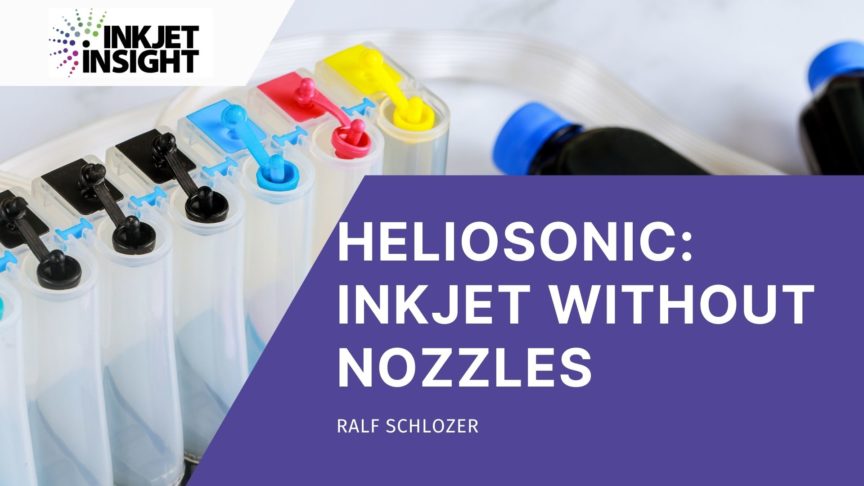Compared to the known and widely used inkjet printing technologies today, there are many other ways to jet ink particles onto a substrate besides the often deployed thermal, piezo and continuous inkjet technologies.
Heliosonic is such a process and as a further unique property it does not use nozzles. The process is now about to be commercialised by Altana – a leading global provider of specialty chemicals, headquartered in Germany. Altana is also a major investor in Landa Digital Printing and acquired the metallographic technology from Landa – now marketed under the Actega Metal Print brand.
The Heliosonic process starts with a carrier material on which a defined ink film is applied. In the proposed process the carrier is a clear polymer ribbon and conventional printing ink can be used. A scanning laser applies energy pulses to the backside of the ribbon according to the image to be formed. The ribbon being transparent lets the laser energy pass before the laser is hitting the underside of the ink film. A small portion of the ink evaporates instantly and jets the remaining layer onto the substrate. Drying or curing is performed according to the ink used. The ink on the ribbon is replenished in an inking unit.
This leads to the big advantage: Heliosonic can print with a very wide range of inks, including standard conventional inks. Widely available offset inks can be used as well as specialty inks for visual effects, functional inks, even polymers pastes. Depending on the ink it might be necessary to add an adsorber (which does not alter the colour) to guarantee sufficient laser absorption or to adjust the rheology. These adaptations are minute, however. Water, solvent and UV inks with the respective drying/curing set-ups are possible. Not requiring nozzles has some distinctive rewards as it is possible to jet large pigment particles, use high viscosity ink, inks with a very high solid content and thixotropic inks (inks becoming more fluid when stress like shear is applied). This all is quite beneficial for functional inks or inks containing specialty/effect pigments and is tough to achieve with the inkjet technologies used today.
The process can be set up as monochrome print unit or for multiple colours, up to full process colour. There have been ideas in the past to use the Heliosonic process as a lower cost alternative to inkjet, based on the low cost of standard offset inks. Taking into account all the progress (aqueous) inkjet has made in recent years, including on ink costs, this is less relevant now.
Three fields of applications are planned at the moment:
- Printed electronics
- Security print
- Specialty applications
The Heliosonic process can be used in stand-alone devices, but could be integrated into conventional presses, like a web label press, as well.
Print speed is a moderate 10 m/min (32 fpm) for now. The print width of the current laser module is 18 cm (7”), although 33 cm wide heads are under consideration. Multiple heads can be stitched for wider widths. Imaging resolution is 300 by 600 dpi, although this can be varied. While this would be low for graphics printing, for printed electronics the resolution is more than sufficient.
Typically ink films up to 20 µm are transferred, although up to 40 µm are possible. The transferred ink film could be much thinner as well, however when aiming at functional print rather the upper end of the bracket is interesting.
Altana is planning to go beta this year with a few selected installations. The company provides the printhead assembly and the inks – although using 3rd party inks is possible as well. Partners provide the integration and substrate transport. A prototype printer can be viewed after signing an NDA. While a wide range of inks is possible, the fine tuning for optimal transfer, homogeneity and performance of the ink will require some testing and fine-tuning. Given the specialty nature of the foreseen applications the targeted installations will rather be projects than off-the-shelf solutions.
Currently Heliosonic is looking for partners to develop projects in which the Heliosonic technology is deployed. This could be printing companies or printing equipment manufacturers with a certain use case in which the Heliosonic technology would fit – for example as an add-on onto a printing press or finishing line.
The Heliosonic process is not competing with existing inkjet technologies, it is rather enlarging the field of applications. Bringing short run production, even potentially variable images to printed electronics is an exciting prospect. Many of the new applications and installations are likely to be operated behind the scenes – typically security and specialty printers are protective of their manufacturing processes. Yet, I hope we will learn about some exciting and unusual inkjet applications soon.

